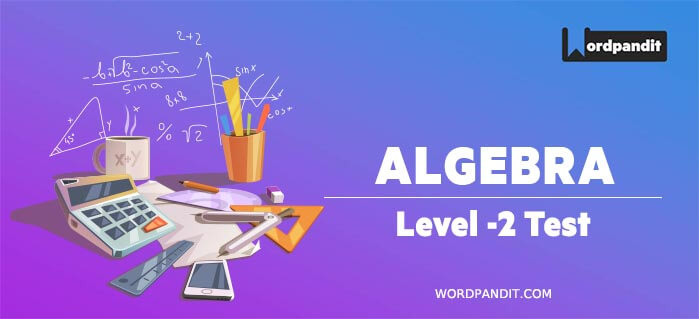- This is an assessment test.
- To draw maximum benefit, study the concepts for the topic concerned.
- Kindly take the tests in this series with a pre-defined schedule.
Algebra Level 2 Test 2
Congratulations - you have completed Algebra Level 2 Test 2.You scored %%SCORE%% out of %%TOTAL%%.You correct answer percentage: %%PERCENTAGE%% .Your performance has been rated as %%RATING%%
Your answers are highlighted below.
Question 1 |
What will be the sum of first 50 odd natural numbers?
1250 | |
2500 | |
2601 | |
2306 |
Question 1 Explanation:
Since the sum of first odd natural numbers = {(last term +1)/2}2
So in general we can say that the sum of first natural odd numbers would be = n2
So in this case the series will become = 1+3+5+7…..99
So therefore the sum of series = n2
n = 50
so the sum would be the square of 50 = 2500
So in general we can say that the sum of first natural odd numbers would be = n2
So in this case the series will become = 1+3+5+7…..99
So therefore the sum of series = n2
n = 50
so the sum would be the square of 50 = 2500
Question 2 |
If 1+2+3+4+….. +40 = 820
Then what will be the value of 21 +22+23+24……….+60
1620 | |
1630 | |
1840 | |
2306 |
Question 2 Explanation:
We will solve this series with logic
We can write the above as:
21 +22+23+24……….+60 = (20 +1) + (20+2) + (20 +3) ………… (20 + 40)
If you see 20 is present in all terms
i.e. 20 came 40 times in the series
so the series can be written as 20 x 40 +(1+2+3……….. 40)
and in the question we are given by 1+2+3+4+….. +40 = 820
so the sum of the series is = 800 + 820 = 1620
We can write the above as:
21 +22+23+24……….+60 = (20 +1) + (20+2) + (20 +3) ………… (20 + 40)
If you see 20 is present in all terms
i.e. 20 came 40 times in the series
so the series can be written as 20 x 40 +(1+2+3……….. 40)
and in the question we are given by 1+2+3+4+….. +40 = 820
so the sum of the series is = 800 + 820 = 1620
Question 3 |
In a book, containing 20 pages, one sheet is missing. Sum of the page numbers of the remaining pages is 195. The numbers written on both the sides of the sheet must be
6, 2 | |
6, 3 | |
7, 8 | |
8, 9 |
Question 3 Explanation:
Since the pages of a book are consecutive numbers,
we can first find the sum of all pages of the book
The sum of pages of the book = {n(n+1)} / 2 = (21 x 20 )/2 = 210
And in the question we are given by the sum of pages excluding the missing page = 195
So the difference between both the values = 210 – 195 = 15
Now check the options, the option with sum of 15 is the right option i.e. option number (c)
we can first find the sum of all pages of the book
The sum of pages of the book = {n(n+1)} / 2 = (21 x 20 )/2 = 210
And in the question we are given by the sum of pages excluding the missing page = 195
So the difference between both the values = 210 – 195 = 15
Now check the options, the option with sum of 15 is the right option i.e. option number (c)
Question 4 |
The product of two positive numbers is 2500. If one is four times the other then the sum of these two numbers would be
120 | |
130 | |
124 | |
125 |
Question 4 Explanation:
Since product of two positive numbers is 2500
Therefore let us consider the number be = p
Then the second number will be = 4p
Now p x 4p = 2500
P2 = 2500/4 = 625
P2 = 625
p = 25
so if the number is 25 then the other number will be = 100
and the sum of these two number would be = 125
Therefore let us consider the number be = p
Then the second number will be = 4p
Now p x 4p = 2500
P2 = 2500/4 = 625
P2 = 625
p = 25
so if the number is 25 then the other number will be = 100
and the sum of these two number would be = 125
Question 5 |
If the difference between the squares of two consecutive numbers is 47 , then what would be the smallest number
20 | |
21 | |
23 | |
25 |
Question 5 Explanation:
If there are consecutive numbers then they will be in the form of (p), (p+1)
Let first number = p
Then the second number would be = (p+1)
We are given that the difference = 47
Here we use a property
The difference of two consecutive squares = sum of those numbers
So p + (p+1) = 47
On solving
P = 23
So the numbers are 23 ,24
Let first number = p
Then the second number would be = (p+1)
We are given that the difference = 47
Here we use a property
The difference of two consecutive squares = sum of those numbers
So p + (p+1) = 47
On solving
P = 23
So the numbers are 23 ,24
Once you are finished, click the button below. Any items you have not completed will be marked incorrect.
There are 5 questions to complete.
List |











